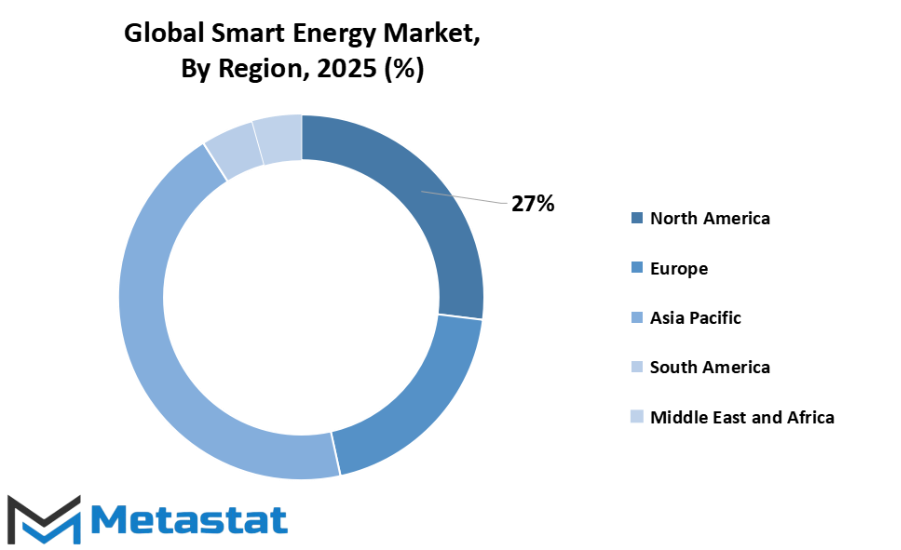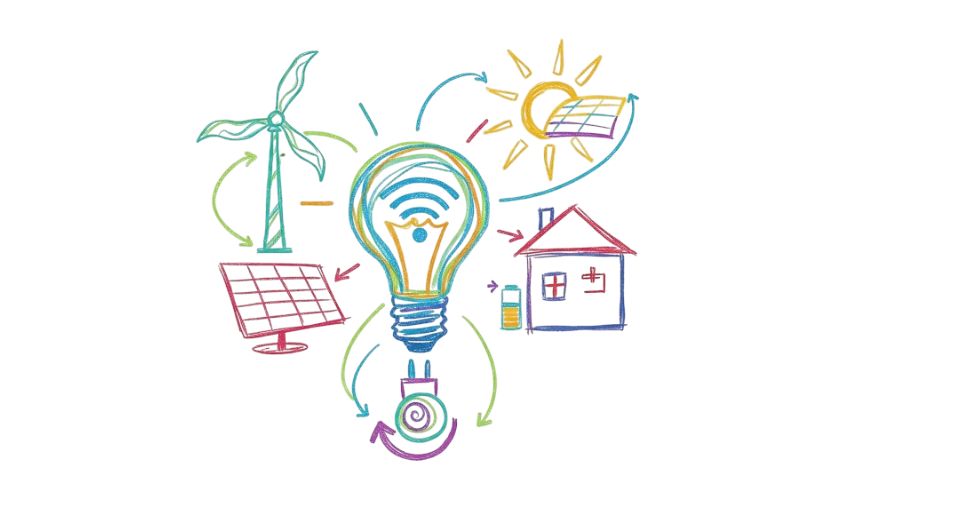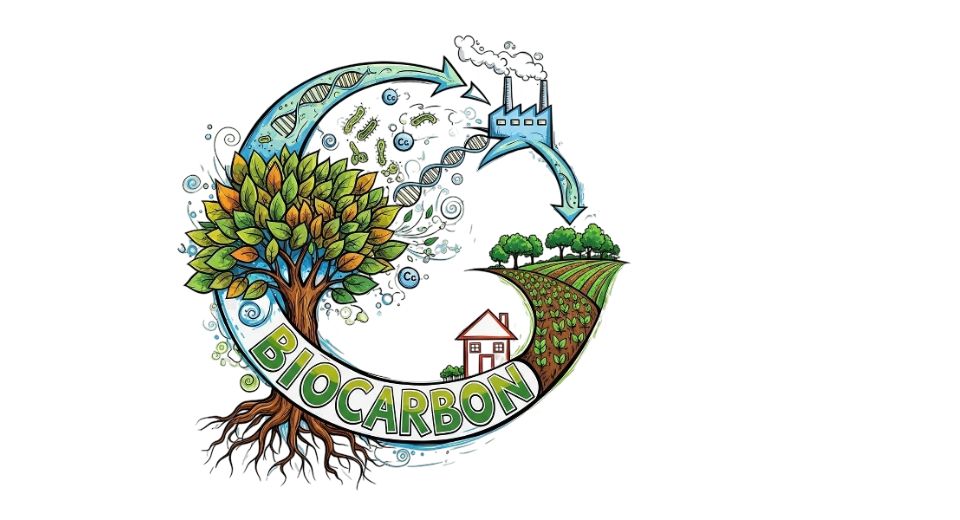MARKET OVERVIEW
The global smart energy market will be one of the most important industries that will revolutionize the way power is going to be produced, distributed, and utilized in countries. It will be the domain of an industry committed to developing highly efficient, technology-focused energy systems that reduce waste, reduce expenditure, and foster sustainability. It will aggregate innovative solutions like smart grids, networked devices, data-based energy management, and decentralized production systems. As the world is heading in the direction of cleaner fuels and more efficiency, the market will be a cornerstone in bringing energy consumption on par with the digital age.
The sector will not confine itself to classical electricity supply or generation networks. Rather, it will encompass combined platforms that will link the producers, consumers, and prosumers on digital platforms and automated systems of control. The global smart energy market will drive traditional infrastructure to develop into networks that can perform real-time monitoring, predictive maintenance, and adaptive flow of energy. This evolution will prepare the energy industry for a world where patterns of demand will be more dynamic and supply chains need to react immediately to fluctuations.
Innovation will lead the way in developing this market. IoT-based sensors, AI-based analytics, and blockchain-based solutions will be utilized to create transparency and accountability within the energy system. The solutions will enable energy participants to predict outages, regulate load distribution, and stabilize the grid more precisely. The sector will also promote the adoption of distributed generation systems, whereby residential and commercial consumers will generate and store power and sell excess electricity to the grid using secure self-sustaining platforms.
Aside from technological breakthroughs, the global smart energy market will also have a strong social and economic impact. Rural villages will have perpetual and low-cost electricity through microgrids and off-grid systems. Smart meters and demand-response programs will be fitted in cities that will enable consumers to control their power usage in real time. These innovations not only will optimize energy efficiency but also create a culture of responsible consumption.
Sustainability will be among the principal outcomes of this industry since it will enable transition to sustainable sources like solar, wind, and hydro by offering smoother integration into the existing power system. The industry will also lead the cutting of greenhouse gas emissions through promoting electrification of transport and low-carbon industrial practices.
In the coming years, the global smart energy market will continue to transform the manner in which societies produce, transport, and interact with energy. It will turn the world into a realm where technology innovation, sustainability, and customer empowerment converge to build future-ready energy systems that are smarter, cleaner, and more progressive.
Global smart energy market is estimated to reach $ 391,794.91 Million by 2032; growing at a CAGR of 10.5% from 2025 to 2032.

GROWTH FACTORS
The global smart energy market will be a key driver of how society in the future produces, delivers, and consumes power. The market will consolidate several products and technologies, such as smart grids, digital oilfields, smart solar systems, home energy management systems, and other networked solutions that will transform the way energy networks function. In the years to come, intelligent grids will be the foundation of power infrastructure that supports two-way interaction between consumers and suppliers. Digital oilfields will be upgraded with sensors and automation to make it possible for energy firms to optimize production and improve safety. Smart solar will allow renewable power to be more easily controlled by seamlessly interfacing it with local and national grids, and home energy management systems will provide homeowners with end-to-end control of their energy usage through connected and mobile devices.
The industry will also be defined by its constituents, which consist of solutions and services that will optimize energy systems to become more efficient and reliable. Future solutions will encompass sophisticated software platforms, data analytics solutions, and automation systems that will track and optimize energy flows in real time. Services will range from installation, maintenance, consulting, and predictive upgrades that will ensure energy networks operate efficiently. This synergy will enable providers to forestall outages, curb wastage, and provide energy at lower costs while ensuring quality and stability.
Applications of the global smart energy market will be diverse, enabling energy efficiency, renewable integration, demand response, and other applications which will become more critical as the world's energy needs expand. Energy efficiency initiatives will decrease consumption without diminishing productivity, and renewable integration will enable countries to draw more power from solar, wind, and other green sources without compromising grid reliability. Demand response programs will offset peak loads by moving loads automatically, making a smarter dynamic between consumers and suppliers.
This market, in the next few years, will not only upgrade infrastructure but will also get the energy industry ready for a future where data, automation, and sustainability come together in harmony. By combining innovation with solutions that work, the Global Smart Energy industry will enable cleaner cities, more intelligent industries, and homes that are also playing an active role in energy management. This will introduce a system that is not just more reliable but also more responsive to human and planetary needs.
MARKET SEGMENTATION
By Product Type
The global smart energy market will redefine the way power systems operate in the future by providing a comprehensive array of products that will help create a smarter and cleaner energy network. Product segmentation will comprise smart grids, digital oilfields, intelligent solar systems, home energy management systems, and other emerging technologies. Smart grids will enable utilities and consumers to communicate with each other in a two-way system, enhancing real-time monitoring and load balancing. This will decrease power losses and avoid power outages. The digital oilfield will be based on automation, sensors, and networked systems to improve drilling, production, and monitoring activities, thereby increasing efficiency and safety. Intelligent solar technology will provide a smooth infusion of the renewable power into the grid without causing instability, enabling the city and town to rely on the sun even during peak periods. Home energy management systems will provide homes with control over their power use via apps and smart devices, and thus enable cost savings as well as overall energy efficiency. Collectively, these devices will revolutionize the generation, distribution, and consumption of energy globally and create a system that will react quicker to demand and be sustainable for years to come.
By Component
The global smart energy market is assuming increasing significance as communities and businesses seek to meet increasing demand for energy while maintaining sustainability. Contemporary cities, manufacturing plants, and homes are shifting towards cleaner and more efficient systems that will shape the way energy is generated, delivered, and used in the future. Industry growth in this field is not merely about reducing prices but also about developing cleverer networks that will adapt to shifting usage patterns. This transformation is ushering in a change in which technology and energy management function in harmony to provide responsive and sustainable power. A detailed examination of the global smart energy market by component reveals how solution and services are driving development.
Smart grids, advanced metering infrastructure, and energy storage systems are some solutions. These instruments will provide improved consumption monitoring, minimized energy loss, and smoother renewable resource integration. With smart grids, for instance, power outages could be reduced since the system will self-adjust and redirect supply wherever it is most needed. Energy storage will also have a key role to play, as it will stabilize and make renewable sources like wind and solar dependable, even when the wind is not blowing or the sun is not shining. Services are also vital to the global smart energy market. System integration, maintenance, and consulting will make solutions run smoothly and be effective in the long term.
Smart teams will assist companies and governments in creating networks that fit the local demand while remaining adaptable to future requirements. Services will also concentrate on cybersecurity, which will become a requirement as energy networks become increasingly networked and digitized. Keeping these systems secure from attacks will be just as critical as producing the energy. Trust-inspiring services will build confidence and stimulate further use of smart energy platforms. Looking ahead, the global smart energy market will continue to grow as urban populations expand and digital technologies advance. Artificial intelligence and data analytics will support smarter decision-making by predicting energy needs with greater accuracy. For instance, patterns of consumption during different seasons or times of day will be anticipated, and systems will adjust automatically to avoid waste.
This forecasting ability will optimize resources and maintain energy expense under management, and it will yield both economic and environmental rewards. Governments and corporations will use these data to make investment plans and achieve climate targets without losing pace. The global smart energy market will also shape the ways communities grow over the next decades. Communities will have buildings that produce some of their power from solar panels, excess energy being returned to the grid. Electric cars will plug into charging stations fueled by clean energy sources, lessening their reliance on fossil fuels. Heavy industries will embrace sophisticated monitoring systems that reduce emissions while enhancing performance.
These transformations will show that technology, supported by careful planning, can usher in a viable energy future that serves humanity and the planet. In short, the global smart energy market, fueled by solutions and services, is clearing the way for a future where efficiency, reliability, and sustainability go hand in hand. Development in this market will not only change the way energy is handled but also shape the platform for cleaner growth in the next years.
By Application
The global smart energy market is moving toward a future where technology, sustainability, and efficiency work hand in hand to reshape how energy is produced, distributed, and consumed. The focus is no longer only on supplying electricity but also on building smarter systems that can balance demand, integrate renewable sources, and cut unnecessary waste. This transition reflects a growing recognition that energy resources must be managed in ways that reduce costs and environmental impact while supporting long-term economic growth.
Looking at the application of energy efficiency, there is a clear path toward advanced monitoring tools and intelligent devices that adjust usage automatically. Sensors, smart meters, and data-driven platforms will make it possible to track consumption patterns in real time. Instead of waiting for monthly bills, households and industries will know exactly where and when energy is being used. This not only lowers unnecessary expenditure but also helps identify opportunities for conservation. Over time, these measures can create large savings and ease the pressure on power grids during peak hours.
Another crucial application is renewable energy integration. Solar panels, wind turbines, and other clean sources are becoming more affordable and widely adopted, yet they also bring challenges due to variations in output. Smart grids will provide the flexibility needed to store excess power and distribute it when the natural supply is lower. Advanced battery systems and intelligent forecasting tools will allow smoother coordination between renewable sources and traditional power plants. The result will be a balanced system where clean energy takes a larger share without risking stability. This approach will make renewable energy not just an alternative but the backbone of future power generation.
Demand response forms the third important application within this market. Traditional energy systems often struggle to adapt quickly to sudden changes in usage. With smart energy solutions, utilities can send signals to consumers encouraging reduced consumption during high-demand periods. Automated systems in buildings, factories, and even electric vehicles can adjust operations temporarily, helping to maintain grid balance. This strategy avoids blackouts and reduces the need for costly emergency power generation. Over the next decades, demand response will play an even greater role as energy use patterns become more complex.
Other applications are emerging that expand the potential of this market further. Artificial intelligence and blockchain are being tested to ensure secure transactions and optimized distribution. Cities are exploring integrated platforms where traffic lights, heating systems, and street lighting coordinate to reduce energy strain. Industrial zones are considering microgrids that run independently but still link with wider national networks when needed. These innovations highlight a growing shift from passive energy consumption to active energy management.
The global smart energy market is expected to grow not only as a result of technology but also due to strong policy support and rising public awareness. Governments worldwide are setting strict targets for emissions reduction and energy savings, while individuals are showing greater interest in sustainable living. The future points toward an interconnected and efficient system where smart applications in efficiency, renewable integration, demand response, and other fields will shape a cleaner and more reliable energy landscape.
By End User
The global smart energy market is redefining the future of how energy will be generated, distributed, and used. With increased demand for efficient and sustainable energy solutions, cutting-edge technologies are now starting to reshape the market's structure. As urbanization and industrialization continue unabated, systems that can maximize energy usage while minimizing waste and enabling renewable energy integration are in high demand. The global smart energy market will be at the forefront of meeting these needs, providing smarter solutions for homes, companies, and industries. For residential purposes, smart energy systems will redefine how homes deal with power.
Smart meters, smart appliances, and energy storage systems will enable homes to use energy more efficiently and reduce expenditure. The capacity to network devices using digital platforms will make it possible for homes to track real-time usage and adjust accordingly, which was never feasible earlier. Moreover, the growing dependence on renewable energy sources like solar panels will make energy management systems that can balance demand and supply in real-time indispensable. The global smart energy market is anticipated to provide solutions that will facilitate this transformation, making it easy for homes to embrace clean and efficient energy habits. In the manufacturing industry, there is a larger need for sophisticated energy solutions. Factories and large manufacturing companies use immense amounts of energy, and wastage in this sector has the potential to cause substantial loss.
The global smart energy market will bring technologies enabling industries to monitor consumption patterns, forecast peak demand, and adjust processes automatically to save energy. Artificial intelligence and automation will be combined to optimize production timing, minimizing downtime and ensuring that machines consume power only when it is needed. This change will not only be cost-saving but also emissions-saving, meeting global carbon reduction targets. The commercial marketplace will also experience dramatic alterations. Offices, retail shops, and service businesses are increasingly relying on technology, and as such energy consumption is increased. The global smart energy market will enable commercial properties to utilize smart grids, energy-efficient lighting, and automated climate control systems to reduce unnecessary consumption.
Building managers will be able to make improved decisions regarding when and how to utilize power through real-time data. With time, this will not only enhance sustainability but also reduce operational costs for companies. In the future, the global smart energy market will be influenced by digital connectivity, artificial intelligence, and the growth of renewable energy. Future energy systems will not operate as stand-alone systems but as networks that connect, share information, and resources. This integrating approach will establish equilibrium between demand and supply across the board, enabling energy to circulate where needed. Home consumers will have more control over energy expenses, businesses will optimize efficiency, and office buildings will be greener.
The global smart energy market will revolutionize energy consumption for the future. It will align sophisticated technology with a day-to-day need and bring forth an ecosystem that promotes efficiency, affordability, and sustainability for residential, industrial, and commercial spaces. It will be a futuristic measure that will not only make future energy systems smarter but also more robust in overcoming the challenges of the future.
|
Forecast Period |
2025-2032 |
|
Market Size in 2025 |
$197,385.99 Million |
|
Market Size by 2032 |
$391,794.91 Million |
|
Growth Rate from 2025 to 2032 |
10.5% |
|
Base Year |
2024 |
|
Regions Covered |
North America, Europe, Asia-Pacific Green, South America, Middle East & Africa |
REGIONAL ANALYSIS
The Smart Energy market globally is distinct between regions based on infrastructure preparedness, energy policies, and technological adoption. In North America, the United States is a leader with increased investment in clean energy, extensive application of smart grids, and government policies that promote clean energy transitions. Canada is also participating in the development of a low-carbon economy with considerable emphasis on hydropower and clean electricity. Mexico is seeing a consistent increase in demand as it builds out its energy infrastructure and works its way towards improved grid management. Collectively, this area should continue to move forward with smart energy adoption, with increasing focus on digital solutions for energy efficiency and sustainability.
Europe is still a prominent source of smart energy growth as nations are continuing to set ambitious climate goals. The UK, Germany, France, and Italy have been aggressively upgrading their grids and promoting smart meter adoption, electric vehicles, and clean energy solutions. They also advance innovation and private-public sector cooperation to drive the transition. The Rest of Europe follows suit, and the continent is thus one of the most advanced markets where consumer interest and regulatory pressure push demand. The region will remain at the forefront in driving global standards in energy efficiency and green technology.
Asia-Pacific is quickly becoming one of the world's most powerful regions in defining the global smart energy market. India and China are aggressively investing in solar, wind, and battery storage solutions as they construct strong digital grids. Frenzied industrialization and urbanization are driving demand upwards, while Japan and South Korea keep growth steady with technological innovation and effective energy management systems. Australia and New Zealand's neighbors in the Rest of Asia-Pacific also offer strong potential as smaller economies develop more infrastructure and move towards renewable solutions to keep this region highly dynamic going forward.
South America is also picking up slowly, led by Brazil and Argentina in renewable energy and smart grid adoption. The drivers are urban development and economic growth, and demand will continue to grow as infrastructure becomes more robust. In the Middle East & Africa, GCC nations heavily invest in smart energy projects to diversify their energy supply away from oil, while Egypt and South Africa demonstrate encouraging progress in grid modernization. The remainder of the region is slowly progressing as access to energy increases, and it becomes an increasing factor in future world demand.
Together, the global smart energy market will grow as mature markets continue to refine their systems while new markets develop new infrastructure and implement digital technologies. Collectively, this guarantees a consistent transition towards cleaner, smarter, and more efficient energy globally.

COMPETITIVE PLAYERS
The global smart energy market will likely maintain a lofty growth trajectory for the foreseeable future, due to numerous countries progressing toward cleaner, more efficient and connected energy systems. Leading companies, such as Siemens AG, Schneider Electric, Honeywell International Inc., Landis + Gyr, General Electric Company, and ABB Ltd., are making bold advancements aimed at developing technologies that enable more efficient energy uses and waste reduction. Companies such as IBM Corporation, Cisco Systems, Inc., and KONTRON AG are using their knowledge of digital solutions and data intelligence to connect, or digitize, energy networks, to become more responsive. Companies such as Holley Technology Ltd., Iskraemeco Group, Itron Inc., and Sensus (Xylem Inc.), are developing new features for smart metering systems, which will afford customers, and their respective utility companies, much more functionality and control in managing their energy usages. Organizations such as Eaton Corporation and Trilliant Holdings, Inc., are now channeling their efforts toward modernization of electrical grids in order to integrate the coming reality of an increasingly electrified future along with an expanding electric vehicle production, smart homes, and connected devices.
Technology solutions that support real-time monitoring, predictive maintenance and automated energy management will shape the future of the global smart energy market. The outcome will be more consistent supply with no power outage risk because demand and supply can be adjusted in real-time. Governments around the world are providing incentives and investing in initiatives to encourage alternative energy resources (solar and wind), which will shift demand toward smarter systems to integrate these resources into the grid. The convergence of energy companies and technology vendors will provide the pathway for this shift.
Another compelling driver that will fuel the market is increasing consciousness among businesses and consumers about saving carbon emissions and energy expenses. With power rates still going up and down, intelligent energy options will assist customers with analyzing consumption patterns and avoiding wasteful use. This trend will not be confined to developed markets but will spread to developing nations where urbanization is generating new demand for stable and efficient power structures.
In all, the global smart energy market will be headed in the direction of a future that is cleaner in terms of energy, smarter grids, and greater consumer choice in how they utilize power. With the participation of major players and their ongoing innovation, the transition to green energy will not only be a possibility but a reality soon.
Smart Energy Market Key Segments:
By Product
- Smart Grid
- Digital Oilfield
- Smart Solar
- Home Energy Management System
- Others
By Component
- Solution
- Services
By Application
- Energy Efficiency
- Renewable Energy Integration
- Demand Response
- Others
By End User
- Residential
- Industrial
- Commercial
Key Global Smart Energy Industry Players
- Siemens AG
- Schneider Electric
- Honeywell International Inc
- Landis + Gyr
- General Electric Company
- ABB Ltd.
- IBM Corporation
- Holley Technology Ltd.
- Cisco Systems, Inc.
- Iskraemeco Group
- Itron Inc.
- Sensus (Xylem Inc.)
- KONTRON AG
- Eaton Corporation
- Trilliant Holdings, Inc.
WHAT REPORT PROVIDES
- Full in-depth analysis of the parent Industry
- Important changes in market and its dynamics
- Segmentation details of the market
- Former, on-going, and projected market analysis in terms of volume and value
- Assessment of niche industry developments
- Market share analysis
- Key strategies of major players
- Emerging segments and regional growth potential








 US: +1 3023308252
US: +1 3023308252






